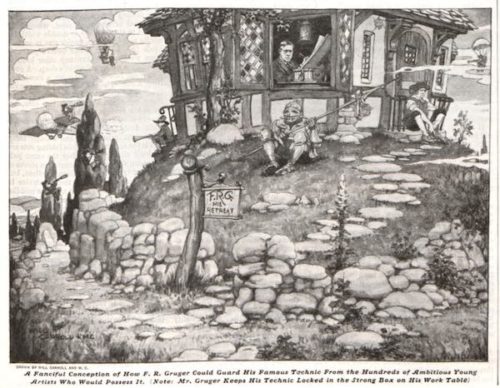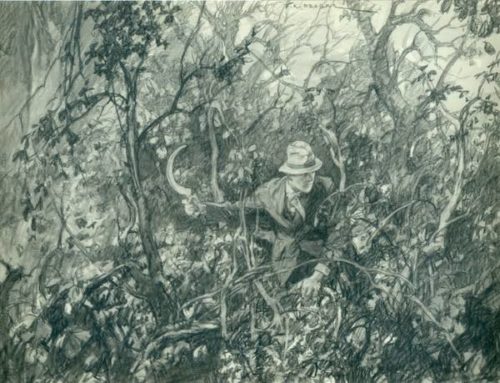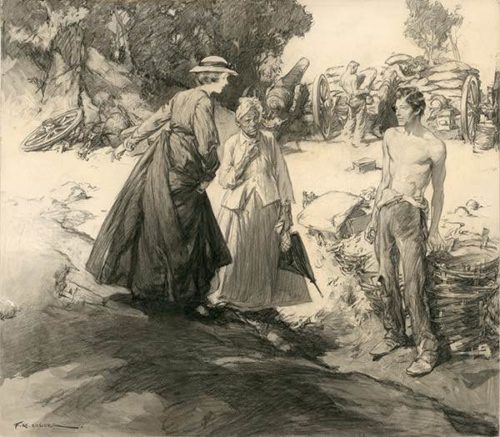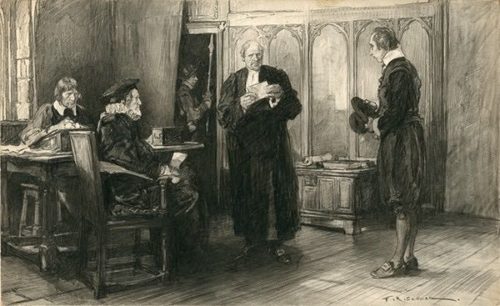The Art of the Post: The Secret Illustration Techniques of Frederic Gruger
In 1928, The Saturday Evening Post published this cartoon about one of its illustrators, Frederic Rodrigo Gruger.

The point of the joke was that artists around the country were dying to learn the secrets of Gruger’s famous technique, which he had to defend with knights in armor.
Never heard of Gruger? He was one of the most highly regarded and prolific illustrators of the day. In 1939, Time proclaimed him “the dean of U.S. magazine illustrators.” Norman Rockwell looked up to him as “one of our greatest illustrators.” His work appeared everywhere — he created an astonishing 6,000 illustrations between 1898 and 1943, but his true home was with the Post, for which he did thousands of illustrations. The same Time article stated, “After 1899 when George Horace Lorimer became editor of The Saturday Evening Post, Gruger became the mainstay of that magazine. The Post’s romantic and period fiction…got half its atmosphere from Gruger’s old fashioned, deep-browed men and frail but credulous women.”
The Post thought he was so famous in 1928 that it was confident its national audience would recognize his name and get the joke about his rivals trying to steal his secrets. Yet, few people remember him today — he hasn’t even made it into Wikipedia!

Frederic Gruger (1871–1953) was born in Philadelphia. His father’s family came from Germany in 1735, and his mother’s family arrived from Spain in 1848. As a boy, Gruger worked in the family’s stone contracting business, but he always knew he wanted to be an artist. He drew constantly, and his left hand bore a permanent blue ink stain, a tattoo mark he acquired at age 3 when he grabbed at his father’s ink-filled pen. Gruger proudly called it “a sort of inoculation.” By the age of 12, Gruger was drawing for a local stationer. At 20, he was working full-time as a staff artist for a newspaper.

He had a long, successful career working for the top magazines and companies, including The Saturday Evening Post, Cosmopolitan, Redbook, Harper’s, Century, Collier’s, Scribner’s, McClure’s, and Good Housekeeping.
So, what was Gruger’s “secret technique” that achieved such great success?
Surprisingly, his technique was just drawing with a pencil on cheap cardboard.
When Gruger first began working on the staff of a newspaper, he learned to draw on flimsy cardboard called “railroad blank.” The newspapers kept stacks of railroad blank lying around for anyone to use as a backing for photos. The cardboard was so cheap, nobody cared how much Gruger borrowed to practice his drawing. It was a simple and frugal way to get art supplies to satisfy his early assignments. As he learned to draw, Gruger found that the cardboard took his pencil well. He experimented with smearing and erasing the carbon pencil to achieve special effects that no one else had achieved. Pretty soon, he became a virtuoso of pencil and cardboard.


Railroad blank was renamed “Gruger board” in recognition of the astonishing work that Gruger was able to perform on it.
As Gruger worked for more prestigious magazines, he rounded out his tools but never strayed too far from his original formula. He’d begin with a light pencil drawing on plain railroad blank. Then he would sometimes go over his initial drawing with a little black watercolor wash to block out large areas for his tonal composition before finishing in pencil. He would use the pencil in a way that created a full range of values, like a master painter. He would start the drawing using a “hard” pencil with a sharp point, then fill in softer sections using a Wolff carbon pencil, which left a rich, velvety black look. These were common tools that were available to anyone in any art supply store.
There was nothing new or innovative about Gruger’s style, either. He admired classical artists such as Rembrandt and Velasquez, and his compositions and values share their dignity and strength.

So you see, Gruger’s “famous technique” wasn’t all that secret. He had no magic recipes. His only protection against imitators was his talent. That turned out to be better protection than a knight in armor.